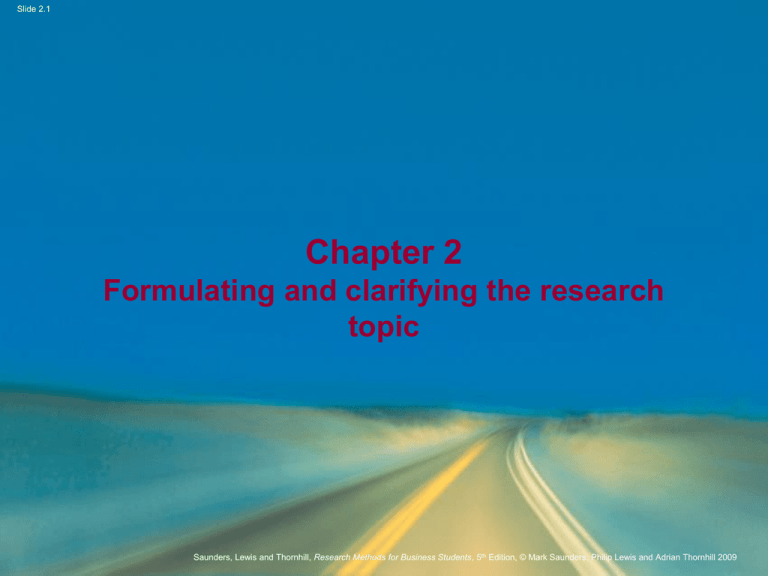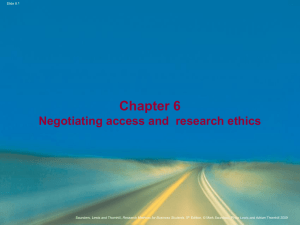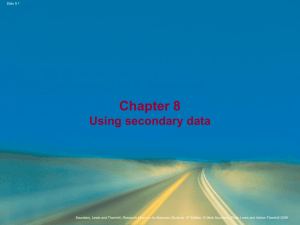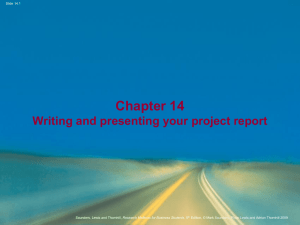Writing research questions
advertisement

Slide 2.1 Chapter 2 Formulating and clarifying the research topic Saunders, Lewis and Thornhill, Research Methods for Business Students, 5th Edition, © Mark Saunders, Philip Lewis and Adrian Thornhill 2009 Slide 2.2 A research paper analyzes a perspective or argues a point Your finished research paper should present your own thinking backed up by others' ideas and information Saunders, Lewis and Thornhill, Research Methods for Business Students, 5th Edition, © Mark Saunders, Philip Lewis and Adrian Thornhill 2009 Slide 2.3 Research Topic may be: Given to you meaning already determined Or You are given the freedom to choose one Saunders, Lewis and Thornhill, Research Methods for Business Students, 5th Edition, © Mark Saunders, Philip Lewis and Adrian Thornhill 2009 Slide 2.4 Formulating and clarifying your research topic The important steps • Identifying the attributes of a good research topic • Generating ideas that help you select a suitable topic • Turning ideas into clear research questions and objectives • Writing your research proposal Saunders, Lewis and Thornhill, Research Methods for Business Students, 5th Edition, © Mark Saunders, Philip Lewis and Adrian Thornhill 2009 Slide 2.5 Attributes of a good research topic (1) Capability: is it feasible? • Are you fascinated by the topic? • Do you have, or can develop within the time frame, the necessary research skills • Can you the project complete in the time available • Will the research still be current when you finish? • Do you have sufficient financial and other resources ? • Will you be able to gain access to data? ? Saunders, Lewis and Thornhill, Research Methods for Business Students, 5th Edition, © Mark Saunders, Philip Lewis and Adrian Thornhill 2009 Slide 2.6 Attributes of a good research topic (2) Appropriateness: is it worthwhile? • Will the examining institute's standards be met? • Does the topic contain issues with • clear links to theory? • Are the research questions and objectives clearly stated • Will the proposed research provide fresh insights into the topic? • Are the findings likely to be ? symmetrical • Does the research topic match your career goals? Saunders, Lewis and Thornhill, Research Methods for Business Students, 5th Edition, © Mark Saunders, Philip Lewis and Adrian Thornhill 2009 Slide 2.7 Attributes of a good research topic (3) And - (if relevant) Does the topic relate clearly to an idea you were given possibly by your organisation ? Saunders, Lewis and Thornhill, Research Methods for Business Students, 5th Edition, © Mark Saunders, Philip Lewis and Adrian Thornhill 2009 Slide 2.8 Generating research ideas Useful Techniques Rational thinking Creative thinking Searching the literature Brainstorming Discussion Relevance Trees Scanning the media Keeping an ideas notebook Exploring past projects Saunders, Lewis and Thornhill, Research Methods for Business Students, 5th Edition, © Mark Saunders, Philip Lewis and Adrian Thornhill 2009 Slide 2.9 Refining research ideas • Using the Delphi Technique : have a group help in providing ideas regarding a specific topic • Conducting a preliminary study • Continually testing out your ideas • Integrating ideas • Refining topics given to you by your organisation Saunders, Lewis and Thornhill, Research Methods for Business Students, 5th Edition, © Mark Saunders, Philip Lewis and Adrian Thornhill 2009 Slide 2.10 From ideas to proposal b will be the consequence literature Question Question Question Objectives 1. S.M.A.R.T See slide 19 Writing the Proposal Deductive approach vs inductive approach Theory: If A is introduced Research idea Saunders, Lewis and Thornhill, Research Methods for Business Students, 5th Edition, © Mark Saunders, Philip Lewis and Adrian Thornhill 2009 Slide 2.11 Writing research questions Write research questions that are • Consistent with expected standards • Able to produce clear conclusions • At the right level ( not too difficult ) • Not too descriptive • Use the ‘Goldilocks Test’ Not too----- Not too----• Just right questions are those that are right for investigation at this time, by this researcher in this setting Clough and Nutbrown (2002) Saunders, Lewis and Thornhill, Research Methods for Business Students, 5th Edition, © Mark Saunders, Philip Lewis and Adrian Thornhill 2009 Slide 2.12 Writing research questions Which of these questions cannot be easily or fully researched A. Do the economies that result from a trash burning plant outweigh or not outweigh its environmental impact It is researchable. You'd have to sift through a lot of information, both pro and con, valid and invalid, in order to choose the best information to answer the research question and support your own point of view, but the point is that there is at least enough information to sift through. Does McDonald's or Burger King make a better burger? It is not researchable as it is worded, since it has no concrete meaning. What does "better" mean? Better in terms of nutrition? Better tasting? Better value? Fewer calories? Better for making your kids happy? This question could become researchable only if you define its terms. Saunders, Lewis and Thornhill, Research Methods for Business Students, 5th Edition, © Mark Saunders, Philip Lewis and Adrian Thornhill 2009 Slide 2.13 Writing research questions A. B. C. A. B. C. Select what you think is the best research question What marketing strategies does the Coca-Cola company currently apply? What is the Coca-Cola company's future marketing plan? What marketing strategies has the Coca-Cola company used in the past? ****** What impact has deregulation had on the airline industry? What percentage of commercial airline crashes were traced to negligent maintenance during the 10 years immediately preceding and following deregulation? What impact has deregulation had on commercial airline safety Saunders, Lewis and Thornhill, Research Methods for Business Students, 5th Edition, © Mark Saunders, Philip Lewis and Adrian Thornhill 2009 Slide 2.14 Writing research questions A. Question "a" is the best research question. Your research to answer this question may include observation of print, television, and radio advertisements as well as research into various current marketing theories and strategies. Both types of research are "do-able," and the question is focused enough to yield a fully-developed research paper. B. Question "b" is very broad as well as being unresearchable--it's unlikely that Coca-Cola personnel will reveal their marketing plan. C. Question "c" may be too broad as well, since "the past" covers a lot of time, especially since the Coca-Cola company was incorporated in 1919 Saunders, Lewis and Thornhill, Research Methods for Business Students, 5th Edition, © Mark Saunders, Philip Lewis and Adrian Thornhill 2009 Slide 2.15 Writing research questions A. Question "a" is too broad, once you get into the research, since deregulation may have had impact on safety, costs, passenger fees, ability to comply with government regulations, and many other areas of the airline industry, too many to deal with in depth in one research paper B. Question "b" is too narrow. It can be answered with simple percentages and cannot be developed into a full research paper. C. Question "c" is the best research question. You may use statistics such as question "b" would uncover as you answer question "c," which is focused enough to allow you to research the question in some depth yet broad enough to allow you to consider the various effects of deregulation on airline safety. Saunders, Lewis and Thornhill, Research Methods for Business Students, 5th Edition, © Mark Saunders, Philip Lewis and Adrian Thornhill 2009 Slide 2.16 Turning ideas into research projects (1) Examples of research ideas and their derived focus questions Table 2.2 Examples of research ideas and their derived focus research questions Saunders, Lewis and Thornhill, Research Methods for Business Students, 5th Edition, © Mark Saunders, Philip Lewis and Adrian Thornhill 2009 Slide 2.17 Turning ideas into research projects (2) Useful techniques • Start with a general focus question • Use the ‘Russian Doll’ principle to reach the essence of the question .Our Version “Cabbage Test” • Discuss areas of interest with your tutor Saunders, Lewis and Thornhill, Research Methods for Business Students, 5th Edition, © Mark Saunders, Philip Lewis and Adrian Thornhill 2009 Slide 2.18 Turning ideas into research projects (3) Writing clear research objectives • Check your examining body’s preferences for stated objectives • Use a general focus question to achieve precise objectives Saunders et al. (2009) Saunders, Lewis and Thornhill, Research Methods for Business Students, 5th Edition, © Mark Saunders, Philip Lewis and Adrian Thornhill 2009 Slide 2.19 Turning ideas into research projects (4) Include SMART Personal objectives S pecific M easurable A chievable R ealistic T imely Saunders, Lewis and Thornhill, Research Methods for Business Students, 5th Edition, © Mark Saunders, Philip Lewis and Adrian Thornhill 2009 Slide 2.20 The importance of theory • Asking for opinions and gathering facts – 'what' questions (descriptive research) • Using questions that go beyond description and require analysis – 'why' questions Phillips and Pugh (2005) In order to: Explain phenomena Analyse relationships Predict outcomes Compare and generalise Saunders, Lewis and Thornhill, Research Methods for Business Students, 5th Edition, © Mark Saunders, Philip Lewis and Adrian Thornhill 2009 Slide 2.21 Writing your research proposal Purposes of the research proposal • To organise your ideas • To convince your audience • To contract with your client (your tutor) • To meet ethical requirements Saunders, Lewis and Thornhill, Research Methods for Business Students, 5th Edition, © Mark Saunders, Philip Lewis and Adrian Thornhill 2009 Slide 2.22 Content of your research proposal (1) • Title - likely to change during the process • Background - context within the literature • Research questions and objectives - what you seek to achieve Saunders, Lewis and Thornhill, Research Methods for Business Students, 5th Edition, © Mark Saunders, Philip Lewis and Adrian Thornhill 2009 Slide 2.23 Content of your research proposal (2) • Method - can be in two parts: research design and data collection • Timescale and Resources - (finance, data access, equipment) • References - include some key literature sources Saunders, Lewis and Thornhill, Research Methods for Business Students, 5th Edition, © Mark Saunders, Philip Lewis and Adrian Thornhill 2009 Slide 2.24 Evaluating research proposals • How the components of the proposal fit together • Viability of the proposal • Absence of preconceived ideas Saunders, Lewis and Thornhill, Research Methods for Business Students, 5th Edition, © Mark Saunders, Philip Lewis and Adrian Thornhill 2009 Slide 2.25 Summary: Chapter 2 The best research topics • Formulate and clarify the topic • Meet the requirements of the examining body • Use a variety of techniques when generating research ideas • Are focused on clear questions based on relevant literature Saunders, Lewis and Thornhill, Research Methods for Business Students, 5th Edition, © Mark Saunders, Philip Lewis and Adrian Thornhill 2009 Slide 2.26 Summary: Chapter 2 The best research topics • Are theory dependent • Have a proposal containing organised ideas Tell the reader: • What will be done and why • How it will be achieved Saunders, Lewis and Thornhill, Research Methods for Business Students, 5th Edition, © Mark Saunders, Philip Lewis and Adrian Thornhill 2009



